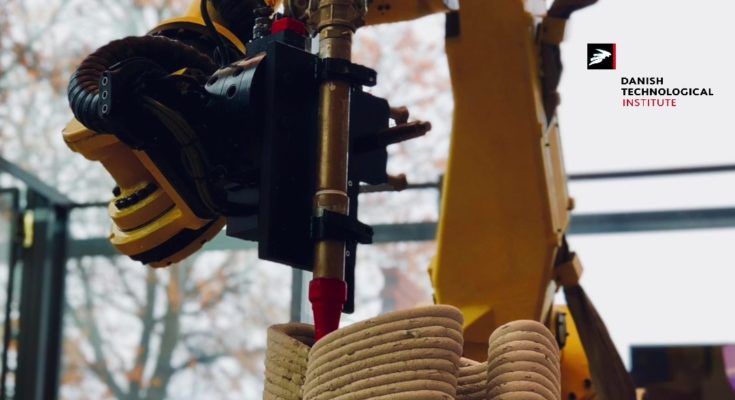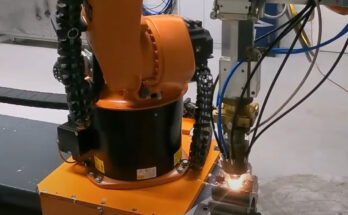Concrete is a challenging material to work with, particularly for robot 3D printing. A team at the Danish Technological Institute are tackling the challenge head-on.
3D Concrete Printing is opening up a world of almost endless possibilities for architects. Robots allow for structures to be printed in almost any shape with a very efficient use of materials.
But, just like any new technology there are challenges. Concrete is a difficult and fickle material to work with, especially when you need the resulting product to have good structural properties.
A group of researchers from the Danish Technological Institute are working to overcome the challenges of concrete printing and push the boundaries of what is possible with 3D printed concrete.
Introducing… the high-technology concrete laboratory
This latest research comes from the high-technology concrete laboratory, which opened at the Danish Technological Institute back in 2007.
This laboratory is devoted to exploring the possibilities of digital fabrication with concrete, including new production methods and forms. Their research uses a variety of tools, but is centered around two pieces of equipment:
- A robot cell using a Fanuc R-2000iC/165F. This is a 6-axis industrial robot with 165kg payload and 2.6m reach, and one of many Fanuc models available in the RoboDK Robot Library.
- A full-scale automated concrete mixing station, which the team uses to experiment with different mixes of concrete.
This type of research is necessary for 3D printed architecture to really reach the mainstream. As a review paper from 2016 found: “[Although] a few isolated products and projects have been preliminarily tested […] it should be noted that such tests and developments on the use of 3-D printing in the construction industry are very fragmented at the time of the study.”
The Danish Technological Institute works closely with industry to bring 3D printing technology into the construction industry. We first introduced the team’s work back in 2017, but they have been making progress since then.
The 5 Challenges of 3D Concrete Printing
The big challenge with 3D printed architecture is the material itself: concrete. If you’ve ever worked with concrete before, you’ll know that it can be a complex material. Its setting time is affected by a whole host of changeable factors, including temperature, humidity, and components. If the concrete mix is not perfect, the structure will not be as strong as it needs to be and it could fail.
Here are 5 challenges that the researchers are trying to overcome, as they explained in a 2018 paper:
1. Balancing Stability and Flow
3D Concrete Printing needs to exist in two different states, which have completely opposite properties.
Before it is extruded, the concrete needs to be easy to pump and achieve a consistent flow. After extrusion, the concrete needs to be stable and strong enough to support further layers of material.
2. Maintaining Workability
The workability of the wet concrete is the key to good printing. Although concrete takes a long time to harden, it quickly loses workability as soon as it is mixed. Additives like water reducing admixtures need to be added to the mix to maintain the required workability.
3. Little or No Deformation After Extrusion
3D printing involves building up layers of material one by one. Each layer is supported by the strength of the previous layer. This is a problem with wet concrete, which tends to “slump” when weight is put on top of it. The team uses a special no-slump concrete mix which can withstand the weight of the layers above, but this introduces more challenges as no-slump concrete can be difficult to pump and prone to cracking.
4. Finely Controlled Setting Times
It is vital that the team are able to precisely match the speed of the robotic 3D printer with the setting time of the concrete, reaching a “set of demand state”. The robot needs to move the printing nozzle at a precise speed. It needs to move fast enough that the layer below does not set too much — which would jeopardize the structure’s stability — but slow enough that the lower levels can hold the new concrete’s weight without collapsing.
5. Avoid Filament Cracking Around Corners
The travel speed of the nozzle is particularly important when the robot is moving around a corner. The movement around corners needs to be quick, which can cause cracking in the print “filament” (the layer of concrete). For this reason, the team’s latest development is a special nozzle which can be turned in tandem with the robot arm.
How the Team Used RoboDK for 3D Printing Concrete
The team’s special printing nozzle is the focus of their latest research. RoboDK was instrumental in programming this new end-effector.
Researcher Wilson Ricardo Leal da Silva explained the setup to us:
“We made a 5-axis print late last year, using code generated in Grasshopper. The goal was to test the nozzle. RoboDK was quite handy to simulate and adjust the robot path.
“We made a simple structure design so we could test the tool-path generated using Rhino — with the RoboDK plugin — and the custom python script we use to control the nozzle via a PLC controller.”
The Key to Success: An Incorporated Workflow
The key to success in the team’s application was their integration with Rhino and its algorithmic modeler Grasshopper.
RoboDK has a dedicated plugin for Rhino which makes it easy to integrate both of these into a combined workflow. We introduced the plugin last year in the article How to Use Rhino + RoboDK for Robot Programming.
Grasshopper is a very popular tool in 3D printing as it makes it easy to create complex shapes via an intuitive visual programming language. With the integrated workflow, the team were able to create their architectural forms using the best tool for the job, then easily export the path to RoboDK and download it to their robot cell.
With the power of advanced concrete mixing and RoboDK, the options for future 3D printed concrete projects are almost limitless. We look forward to seeing what the team at the Danish Technological Institute come up with next!
How could you use Grasshopper/Rhino in your applications? Tell us in the comments below or join the discussion on LinkedIn, Twitter, Facebook, Instagram or in the RoboDK Forum.




